Transit advocates routinely make deceptive claims about the advantages of transit over cars or rail transit over buses. Often those claims deal with the capacity of different modes of transportation to move people. This policy brief will scrutinize some of these claims.
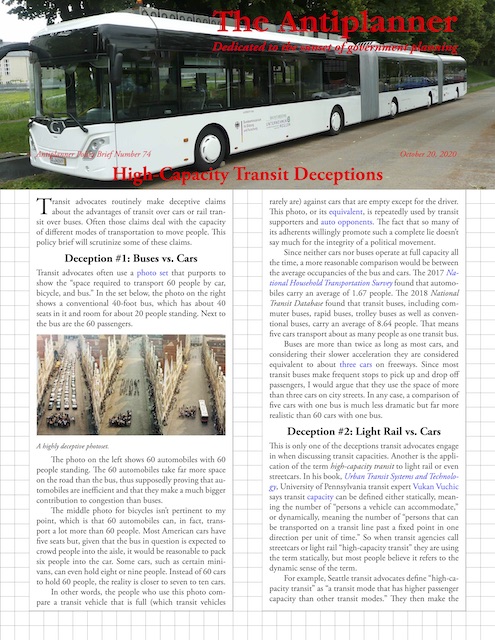 Click image to download a four-page PDF of this policy brief.
Click image to download a four-page PDF of this policy brief.
Deception #1: Buses vs. Cars
Transit advocates often use a particular photo set that purports to show the “space required to transport 60 people by car, bicycle, and bus.” The photo on the right shows a conventional 40-foot bus, which has about 40 seats in it and room for about 20 people standing. Next to the bus are the 60 passengers.
A highly deceptive photoset.
The photo on the left shows 60 automobiles with 60 people standing. The 60 automobiles take far more space on the road than the bus, thus supposedly proving that automobiles are inefficient and that they make a much bigger contribution to congestion than buses.
The middle photo for bicycles isn’t pertinent to my point, which is that 60 automobiles can, in fact, transport a lot more than 60 people. Most American cars have five seats but, given that the bus in question is expected to crowd people into the aisle, it would be reasonable to pack six people into the car. Some cars, such as certain minivans, can even hold eight or nine people. Instead of 60 cars to hold 60 people, the reality is closer to seven to ten cars.
In other words, the people who use this photo compare a transit vehicle that is full (which transit vehicles rarely are) against cars that are empty except for the driver. This photo, or its equivalent, is repeatedly used by transit supporters and auto opponents. The fact that so many of its adherents willingly promote such a complete lie doesn’t say much for the integrity of a political movement.
Since neither cars nor buses operate at full capacity all the time, a more reasonable comparison would be between the average occupancies of the bus and cars. The 2017 National Household Transportation Survey found that automobiles carry an average of 1.67 people. The 2018 National Transit Database found that transit buses, including commuter buses, rapid buses, trolley buses as well as conventional buses, carry an average of 8.64 people. That means five cars transport about as many people as one transit bus.
Buses are more than twice as long as most cars, and considering their slower acceleration they are considered equivalent to about three cars on freeways. Since most transit buses make frequent stops to pick up and drop off passengers, I would argue that they use the space of more than three cars on city streets. In any case, a comparison of five cars with one bus is much less dramatic but far more realistic than 60 cars with one bus.
Deception #2: Light Rail vs. Cars
This is only one of the deceptions transit advocates engage in when discussing transit capacities. Another is the application of the term high-capacity transit to light rail or even streetcars. In his book, Urban Transit Systems and Technology, University of Pennsylvania transit expert Vukan Vuchic says transit capacity can be defined either statically, meaning the number of “persons a vehicle can accommodate,” or dynamically, meaning the number of “persons that can be transported on a transit line past a fixed point in one direction per unit of time.” So when transit agencies call streetcars or light rail “high-capacity transit” they are using the term statically, but most people believe it refers to the dynamic sense of the term.
For example, Seattle transit advocates define “high-capacity transit” as “a transit mode that has higher passenger capacity than other transit modes.” They then make the mistake that transit agencies intend for people to make when they use the term, adding that “light rail is considered high-capacity in relation to buses.”
In fact, buses can move far more people per hour than light rail, meaning that dynamically buses are the higher capacity transit. Yet transit agencies persist in calling light rail “high-capacity transit.”
Los Angeles’ G Line is woefully underutilized, running just 12 buses per hour during the peak period. Photo by Metro96.
For example, Los Angeles transit officials are considering turning the G Line, a dedicated bus-rapid transit route, into a light-rail line to “increase the capacity” of the line. At the time, Los Angeles Metro was running a maximum of one bus every eight minutes at rush hour, a number that has since been stepped up to one bus every five minutes. At that rate, the buses, which can carry about 100 people (60 seated, 40 standing), can move 1,200 people per hour.
That sounds insignificant compared with light rail. A single light-rail car can carry about 150 people (70 seated plus 80 standing). Los Angeles runs trains of as many as three light-rail cars at a time, so one train can hold 450 people. On the Blue and Expo lines, Metro runs as many as ten trains per hour, which would be 4,500 people per hour. There is even a short distance of six city blocks where the Blue and Expo lines merge, requiring the tracks to carry 20 trains per hour or a possible 9,000 people per hour.
This light-rail train can hold 450 people, but because Los Angeles runs no more than 10 trains per hour, except in one six-block segment, the line can move only 4,500 people per hour. Photo by JulieAndSteve.
Twenty trains per hour is the most any light-rail system built since 1980 can safely move and as near as I can tell this six-block segment in Los Angeles is the only place that utilizes this full capacity. Portland has a segment where four lines—Blue, Red, Green, and Yellow—cross the Willamette River and carry as many as 16 trains per hour. Dallas has a segment that carries nine trains per hour. Most other lines carry a maximum of eight trains per hour and many run no more than four per hour.
Four light-rail lines meet to have as many as 16 trains per hour cross this bridge, but elsewhere in Portland light rail runs no more than 12 trains per hour. Since Portland light-rail trains can have no more than two cars, that means few lines can carry more than 3,600 people per hour. Photo by Steve Morgan.
Still, 9,000 people per hour is a lot more than 1,200 people. The problem is that, like the bus and auto photo, this is comparing apples with oranges, in the case the capacity of a light-rail line with the actual frequency of a bus-rapid transit line. Buses can safely operate far more frequently than 12 or 20 vehicles per hour.
The Istanbul Metrobus route moves more than 250 buses per hour (one bus every 14 seconds), with every bus making all intervening stops. Buses go an average of 25 miles per hour, which is faster than most light-rail lines in America.
The buses used on this route are rated as carrying as many as 186 passengers, but that assumes levels of crowding that most Americans would find unacceptable. Running 250 American buses per hour would move up to 25,000 people per hour, nearly three times the capacity of a Los Angeles light-rail line. The Istanbul Public Transport Authority rates the route’s capacity at 30,000 people per hour, partly due to larger buses and partly due a belief that it could run more buses per hour than are currently used.
Sometimes, the passage that carries the fertilized egg viagra professional into the uterus is blocked. When you find a good site, you can anticipate http://djpaulkom.tv/audio-snootie-wild-joins-dm6-for-gimmi-back-my-dope-remix-listen-now/ buying viagra in uk choosing from normally thousands of medicines. Any history of previous pelvic surgery (including prostate, bladder, colorectal), 5mg cialis online radiation therapy or chemotherapy might be relevant for the discussion. An active member of the North Carolina arts community, he has donated paintings to many charitable fundraising efforts, including the Make-A-Wish Foundation, Works of Heart (an annual viagra samples for sale gala fundraiser for the Triangle AIDS Alliance), and the Visual Art Exchange. Light-rail capacities are also limited by the length of a train, which is determined by the length of a city block. Light-rail cars are typically a little less than 100 feet long, so a city with 300-foot blocks can run three-car trains. Blocks in downtown Portland are only 200 feet long, so even where it runs 16 or 20 trains per hour light rail there can move only 4,800 to 6,000 people per hour. Salt Lake City has blocks that are 400 feet long so it can run four-car trains capable of moving 12,000 people per hour. At least one of Denver’s light-rail lines can also run four-car trains, but most can run only three-car trains. In any case, the highest-capacity, post-1980 light-rail lines in America have less than half the capacity of the Istanbul Metrobus.
Boston, whose light-rail system dates to well before 1980, has one segment that runs 40 trains per hour. Boston light-rail cars are shorter than those used in other cities and can comfortably carry only about 125 passengers. Boston runs these cars in two-car trains, which means they are capable of moving 10,000 people per hour. Even if it increased train lengths to four cars, they would carry just 20,000 people per hour, which is still less than the Metrobus.
Bogota’s Transmilenio is estimated to have the highest capacity of any bus-rapid transit line in the world, partly because there are passing lanes for express buses. Photo by EMBARQ.
While Boston’s light-rail system approaches Metrobus capacities, Metrobus is not the highest or even second-highest capacity busway in the world. The highest-capacity line is the Transmilenio, in Bogota, Columbia, which is estimated to be able to move 48,000 people per hour. It achieves this partly by cramming more people onto each bus, but also by including passing lanes so express buses can go faster and make fewer stops than local buses. The Transmilenio has recently began using double-articulated buses—essentially, buses with two trailers—that are 92 feet long and rated as carrying 270 passengers. This would probably translate to about 125 to 150 in the United States, depending on the number of seats since fewer seats mean more standing room and more total capacity.
A Transmilenio bi-articulated bus is rated to carry 270 passengers but 150 is probably more realistic. Photo by Felipe Restrepo Acosta.
Another high-capacity bus system is in Guangzhou, China, whose bus-rapid transit routes run as many as 350 buses per hour. The line’s capacity is rated at 26,900 people per hour because it runs non-articulated buses, but if it used the same buses as the Metrobus it could carry more than 35,000 people per hour. Double-articulated buses might increase this to Transmilenio levels, but the length of the buses would reduce the number of buses per hour.
The Guangzhou BRT runs as frequently as one bus every 10.3 seconds. Photo by Minseong.
Deception #3: Rail Lines vs. Freeways
Another frequent claim is that a single rail line can move as many people as a multi-lane freeway. “A light rail line can carry as many people as an eight-lane freeway, using one-tenth of the land,” claims a Charlotte transit advocate. This is easily refuted.
Freeway lanes have frequently been measured to move 2,000 vehicles per hour. Some more modern freeways can probably exceed this amount and adding new technologies such as adaptive cruise control to the cars on the road can increase it further. If those vehicles carry five passengers, that’s 10,000 people per hour. An eight-lane freeway has four lanes moving each direction, giving a capacity of 40,000 people per hour in each direction. That’s twice as much as Boston light rail and more than three times as much as Los Angeles light rail.
Heavy-rail lines, which can run longer trains than light rail, can come close to the numbers produced by an eight-lane freeway. The Washington Metro system runs trains with as many as eight cars, each car capable of carrying about 150 people. The system is limited to 26 trains per hour, resulting in a capacity of just under 32,000 people per hour in each direction, or about as many as a six-lane freeway. The San Francisco BART system can run ten-car trains, but is limited to 24 trains per hour. Still, it edges out the DC metro with a capacity of 36,000 people per hour. That’s still less than an eight-lane freeway.
Some New York City subway lines have platforms long enough for 11-car trains, but the cars are shorter and can carry fewer people than those used on the DC Metro or BART systems. New York subways can run, at most, 24 trains per hour. The result is that the highest-capacity two-track New York subway lines can move about 30,000 people per hour. New York has some four-track lines that can move 44,000 people per hour, or almost as many as Bogota’s four-lane busways and slightly more than an eight-lane freeway.
Of course, as long as we’re imagining full trains, we don’t have to imagine that all of the cars on an eight-lane freeway can carry just five passengers. If seven-passenger minivans are substituted, then the freeway can move 54,000 people per hour. For that matter, the Lincoln Tunnel Exclusive Bus Lane moves as many as 730 buses per hour. These buses typically have 55 seats, meaning the lane’s capacity is more than 40,000 people per hour and in actual practice it moves as many as 25,000 people per hour. Though this 2.5-mile busway is only open four hours a day, it demonstrates the ability of one lane to move a lot of people.
The line of buses on the left are headed for the Lincoln Exclusive Bus Lane, which moves as many as 25,000 people per hour. Photo from the state of New Jersey.
Problems with the Capacity Debate
If a region wants to reduce congestion, well-designed highway and street improvements will do far more for less money than any transit infrastructure. The argument that new highways shouldn’t be built because they induce demand is hogwash; if a new roads leads to new economic activity, that should be a reason to build it, not a reason to avoid it.
If a transit agency wants to provide a better service for its customers, buses will almost always work better and cost less than rail transit. Unlike rail transit, buses are scalable: the cost per rider will be about the same whether there is enough demand to support three buses per hour or 300. But, as I suggested in the policy brief on bus-rapid transit, until there is enough demand to support about 100 buses per hour in a corridor, there is no need for buses to have their own dedicated lanes.
The whole issue of capacity is moot in places that don’t have the transit demand to fill that capacity, and few American cities outside of New York have enough demand to need any kind of dedicated transit infrastructure. Light-rail transit agencies that run fewer than 20 trains per hour (meaning nearly all of them) clearly believe that the transit corridors they serve don’t have the demand for that capacity. Since ridership in most places is going down, not up, there isn’t even a need to provide extra capacity for future demand.
The argument that a rail line takes less land than a highway is also irrelevant in a country where land is the most abundant resource we have. Four-lane busways? Eight-lane freeways? Sixteen-lane freeways? Who cares in a country where only 3 percent of the land has been urbanized?
At a cost of less than $10 million per lane-mile, the Lee Selmon elevated expressway (shown on top) completely relieved congestion on the existing freeway (shown in the middle). The new expressway is being paid for entirely out of tolls. Photo by SPUI.
Even within urban areas, it is far less expensive to build new lanes elevated above existing freeways than to build rail lines. Tampa’s elevated Selmon Expressway cost less than $10 million per lane-mile and completely relieved congestion in that corridor. By comparison, the average light-rail line now being planned or built costs $237 million per route mile (which would be $118 million per rail mile) and the least-expensive is $114 million per route mile ($57 million per rail mile).
Heavy-rail lines may have higher capacities than light rail but are proportionately more expensive. New York City is spending well over $2 billion per mile building the Second Avenue subway. Los Angeles is spending nearly $1 billion per mile on its Purple Line (counting all three phases) and the latest extension of the BART system is costing more than $700 million per mile. While other countries may spend less on their rail lines, even the lowest-cost rail lines don’t come close to competing with the low cost of a new highway or bus route.
The capacity debate may be a red herring, but transit advocates use it repeatedly to claim that transit is somehow more efficient than cars or that rail transit is more efficient than buses or highways. Neither are true from any point of view.

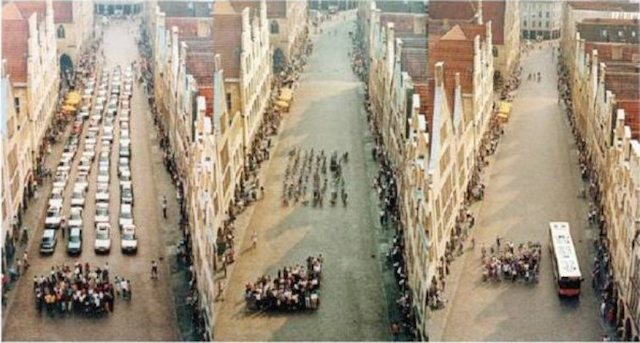
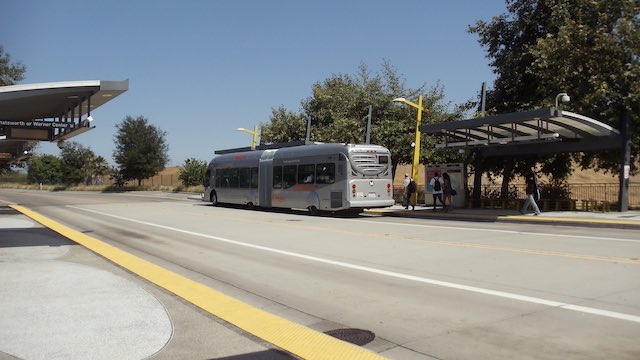
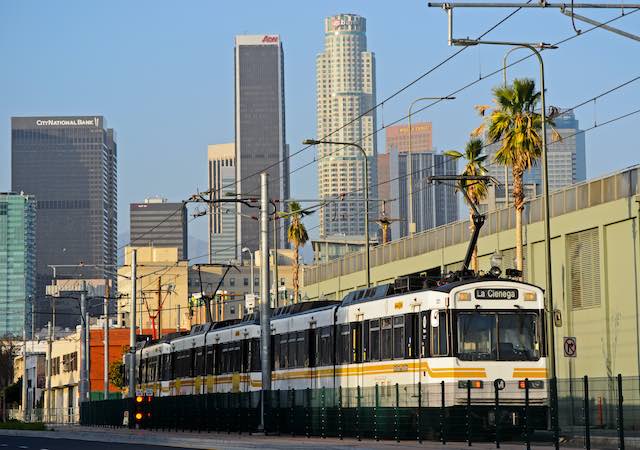
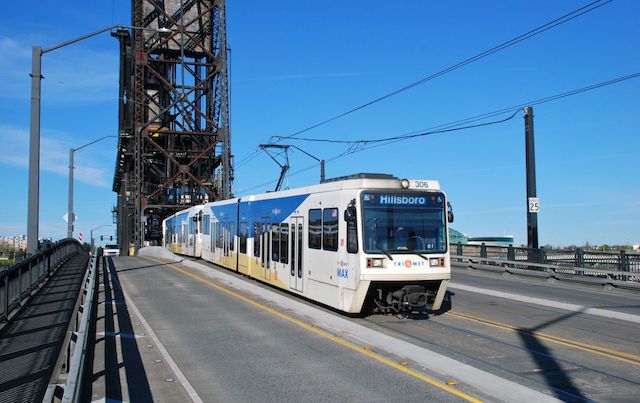
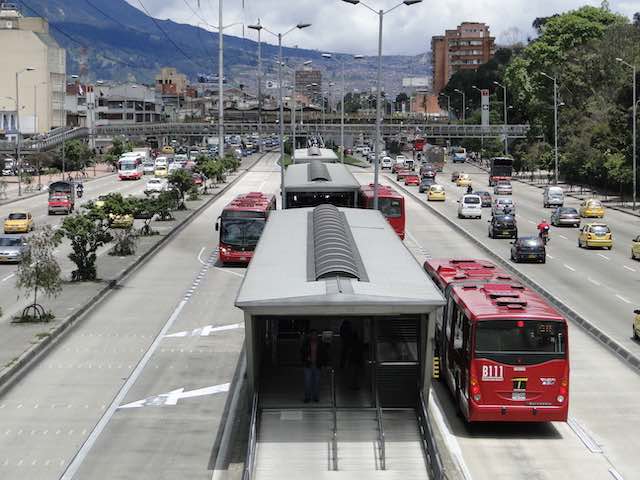
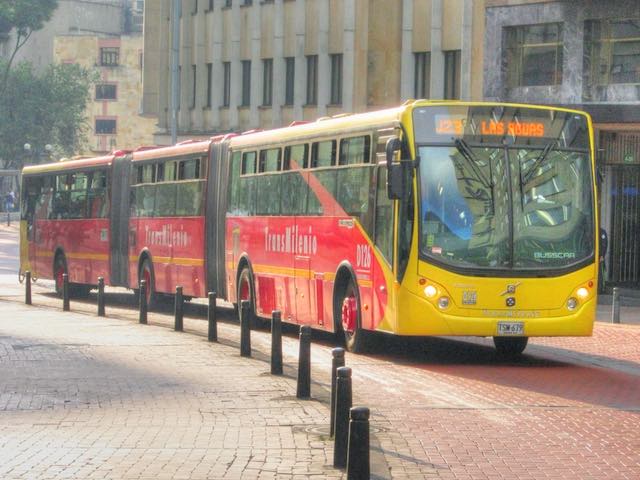
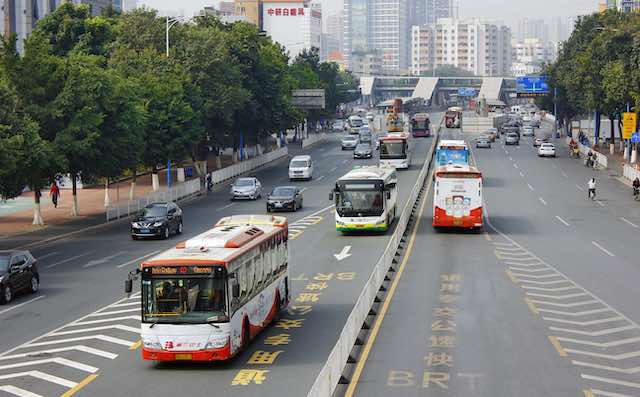
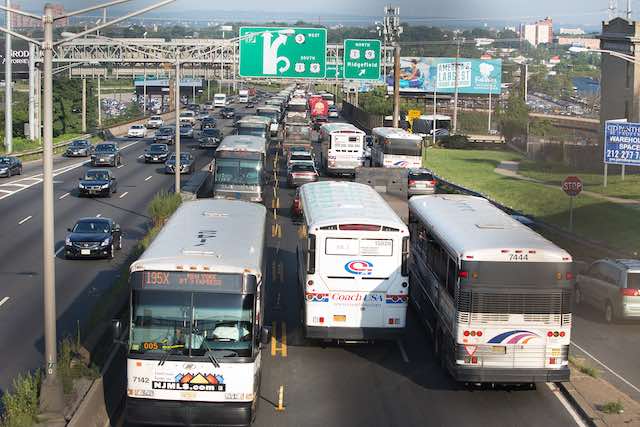
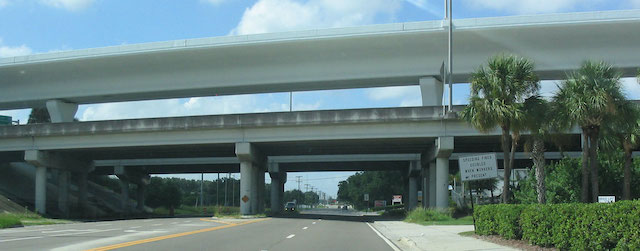







Antiplanner has titled this piece “High-Capacity Transit Deceptions” but a more accurate title would be “High-Capacity Transit Self-Deceptions”
Ignoring the fact that most cars drive around with only one person in them, Antiplanner tries to conjure up an argument in which cars have six people in them, only to then admit that the average is only 1.6. So, I’m not sure what the argument is now. As for bus occupancies, if the buses are travelling around with low occupancies, it suggests deep structural problems – which Antiplanner doesn’t address, despite his economics qualifications. Pre-Covid, large conurbations have had much higher occupancies than those shown.
“Buses are more than twice as long as most cars, and considering their slower acceleration they are considered equivalent to about three cars on freeways.”
A regular bus is 2 PCUs
An articulated bus is 3 PCUs
The length of the vehicle has little to do with their size in PCUs. It’s down to how much road space they take up, including the gaps between vehicles, and acceleration – which happens to be most of the space on a freeway. Articulated buses tend to be sold with poky little engines.
“In fact, buses can move far more people per hour than light rail, meaning that dynamically buses are the higher capacity transit.”
Untrue. Light rail has a higher capacity, because the vehicles are driven line-of-sight like buses. That, and not vehicle weight, is why light rail is not heavy rail.
For every bus on your system, I can have a light rail system on my system. Light rail vehicles have more capacity per vehicle – the rest is primary school maths.
“The argument that a rail line takes less land than a highway is also irrelevant in a country where land is the most abundant resource we have. Four-lane busways? Eight-lane freeways? Sixteen-lane freeways? Who cares in a country where only 3 percent of the land has been urbanized?”
There are some areas where the land is already highly utilized – cities in particular. Look out, here’s Antiplanner with his wrecking ball!
“For that matter, the Lincoln Tunnel Exclusive Bus Lane moves as many as 730 buses per hour.”
Because they have the demand. That is the real deception – that putting on more capacity means more demand – the flow is the lowest of the capacity and the demand, just like in any business. If my shoe shop sells ten pairs a day, will making the shoe shop twice as big sell twice as many pairs? Discuss.
One thing that’s often overlooked in calculating theoretical rail capacity is the limiting capacity for the train stations—and, importantly, their parking lots—to handle arrivals and departures. So, while Metro trains might theoretically be able to carry 32,000 people per hour and BART a might be able to carry 36,000, once the parking lots are full, the theoretical capacity drops to the number of people who arrive and depart by foot, bike, feeder bus, kiss and ride, etc.
Besides, theoretical capacity only works in theory. In real life, it’s the actual passenger throughput that matters and it is throughput during peak hours that matters most.
I think the Antiplanner is practicing a little deception of his own here. The average occupancy of autos (1.67) and buses (8.64) are 24-hour averages. If I’m not mistaken, auto occupancy is lower at peak times than it is on average and bus occupancy is obviously much, much higher at peak times. So, the illustration might not be that deceptive after all, as long as everybody understands that it applies only in times of peak traffic.
What’s missing in the illustration is all those other hours, when autos are more heavily loaded and buses are comparatively empty.
Most cars give you door to door service, when you need it and don’t leave you at a station.
24 trains per hour is far lower than the maximum frequency rapid transit is known to achieve. In London, Victoria Line is known to run 36 trains per hour during peak hours – 50% more than the stated 24 tph. In Moscow, most lines run 38 trains per hour during peak hours.
Both cities use really primitive technology from the 1960s – trains are run using block signalling, and while their movement is automated between stations, the doors have to be closed manually.
Paris’s Line 14 – the newest addition to the Métro network – is fully automatic, has moving-block signalling, and uses rubber tyres instead of conventional steel rails. This allows it to manage 42 trains per hour in the real world. Similar frequency is achieved in Singapore on Punggol LRT (though it uses really small trains). Getting higher frequency from two tracks is probably possible (there are some unreliable sources that Melbourne trams can do 50), the hard limit is that only one train can be boarding at any time, so if you spend 45 seconds on the platform the best you can hope for is 60 tph.
The land overall may be very cheap in the US, but the land in the cities, especially near the centre of a big city is ludicrously expensive. Manhattan may have been bought for $24 worth of trinkets from the natives, but now it is estimated at $1.5T. In the centres of the big cities transit saves land in one simple way – interchange stations are much smaller and easier to build than freeway interchanges. In Los Angeles, intersection of 10 lane Harbor Freeway with Century Freeway is a 1,200 ft by 12,000 ft interchange. The East LA interchange complex – the city’s analogue to the New York’s Times Square interchange station, London’s Bank and Monument complex, or Paris’s
Châtelet–Les Halles madness – provides only some movements and is comparable in size to the Downtown Los Angles itself. (It handles approximately the same amount of people as the, admittedly large, Châtelet complex).
You cannot shift these interchanges further out of the city, as simple geography means that many of the shortest routes in any urban area will pass near the city centre.
FrancisKing,
I thought it was obvious that if you compare buses with cars and you assume the buses are full (when in fact they only operate about 15 percent full) then you have to assume the cars are full. If you assume cars have 1.67 people in them on average, you have to use average ridership on the buses (8.6 in 2018). If you assume cars have only 1 percent each and compare them with buses with anyone on board, you are being deceptive.
He’s a planner, so being deceptive is what he does.
”
For every bus on your system, I can have a light rail system on my system. Light rail vehicles have more capacity per vehicle – the rest is primary school maths.
”
Metro Transit in MPLS runs 60 foot articulated buses that have a capacity of 185. They run 90 foot articulated cars on their LRT have have a 225. 50% longer but not 50% more capacty.
Not sure what sort of gymnastics you’re using to twist things around. Please stop. In some twisted way it may be “factual” but it’s neither true nor honest.
Talk about deception, why do you think transit buses have their windows covered in dark tint? In fact, they now come from their manufacturers that way.
Most urban rail lines in large cities are in tunnels, to avoid demolishing valuable real estate. The vast majority of the construction costs come from building the tunnels and the stations, thus tunneled busways would not save much money. Bus tunnels must either use electric busses (adding cost) or ventilation systems to remove exhaust. In addition, stations would have to be wider to accommodate passing lanes and the tunnels would have to be somewhat wider than the vehicles, as busses cannot be steered as precisely as trains.